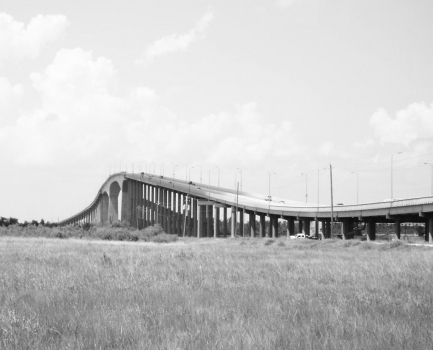General Information
| Other name(s): | Jesse H. Jones Memorial Bridge |
|---|---|
| Beginning of works: | 1980 |
| Completion: | 6 May 1982 |
| Status: | in use |
Project Type
| Structure: |
Box girder bridge |
|---|---|
| Function / usage: |
Motorway bridge / freeway bridge |
| Construction method: |
Balanced cantilever method |
| Structure: |
Haunched girder bridge |
| Material: |
Prestressed concrete bridge Structurae Plus/Pro - Subscribe Now! |
Location
| Location: |
Houston, Harris County, Texas, USA |
|---|---|
| Crosses: |
|
| Will be replaced by: |
Houston Ship Channel Bridge (2024)
|
| Coordinates: | 29° 44' 9.46" N 95° 8' 45.15" W |
Technical Information
Dimensions
| total length | 3.2 km | |
| main bridge | ||
|---|---|---|
| length | 475.5 m | |
| span lengths | 114 m - 229 m - 114 m | |
| clearance | 53 m x 152 m | |
| number of spans | 3 | |
| deck | deck depth | 4.60 - 14.30 m |
| deck width | 18 m | |
Cost
| cost of construction | United States dollar 60 000 000 |
Materials
| deck |
prestressed concrete
|
|---|---|
| piers |
reinforced concrete
|
| deck of approach viaducts |
precast prestressed concrete
|
Excerpt from Wikipedia
Sam Houston Tollway Ship Channel Bridge (formerly known as the Jesse H. Jones Memorial Bridge) is a bridge in Harris County, Texas. It was acquired from the then–Texas Turnpike Authority (TTA) (now North Texas Tollway Authority) on May 5, 1994, and is now a part of the Harris County Toll Road Authority system. The bridge opened to traffic in May 1982. It carries four lanes of Beltway 8 over the Houston Ship Channel with a clearance of 175 feet (53 m).
Conception
The 1952 City of Houston planning document recommended a second loop designated the Outer Belt. Harris County took control of the project in 1960. Efforts to construct the Beltway 8 crossing started in the mid-1960s, culminating in an effort vetoed by Governor John Connally on June 18, 1967. Voters twice rejected bond funds for the bridge, so the effort was reconstituted as a toll bridge. This did not work at that time.
In 1978, the Texas Turnpike Authority performed a study showing the project as feasible, and sold $102M (approximately $333.1M in 2008) of bonds to fund it.
Among designs looked at, a cable-stayed design was studied, but not sufficiently understood at the time. Such was later used on the Fred Hartman Bridge, but in 1978 when this bridge was designed, the only U.S. example of a cable-stayed bridge was the Ed Hendler Bridge, meaning there was a deficiency of design and construction experience for the bridge type.
Construction and financing
Construction completed in 1982 and the bridge was opened on May 6. At the time of completion, the bridge was the longest box girder span in the Western Hemisphere, which record it held until 1997 and the opening of the Confederation Bridge. It is no longer in the top 20 of longest box girder spans.
Traffic volume had been projected to be 4 million vehicles in 1982, but came in at only 1.69 million, a 58-percent shortfall. This was attributed to a lack of connections to the bridge. Additional ramps were completed in 1984, but the results were insufficient to service the bonds. The bonds were refinanced in 1985 at a rate of 12.625 percent (original rate was 7.54 percent), and could not be paid off until July 1, 2002. Total debt service as of the end of 1985 was $522M, with a minimum of $176M.
Traffic volume increased, but not sufficiently to cover the 1985 junk bonds. In 1994, Harris County took over the bridge for the consideration of TxDOT contributing money toward further area highway construction. By 2002, the average toll of $2 brought in approximately $20M, enough to cover bond payments.
In January 8, 2016, the toll bridge was EZ TAG only; According to the Texas Department of Transportation, this removed the toll plazas into the bridge and drivers going to the bridge will need an EZ Tag. This is because of a widening project.
Future
In 2018, construction began on a twin-span cable-stayed bridge to replace the existing one. The replacement bridges are designed by Figg Engineering Group and the contractor for the project is Ship Channel Constructors, a joint venture between Traylor Brothers Inc. and Zachry Construction Corp. When completed, each bridge will carry 4 lanes of one-way traffic. The bridges will take three years each to be completed, with the southbound bridge set for completion in 2021 and the northbound bridge in 2024. When the southbound bridge is completed the existing bridge will be demolished and the northbound bridge will be built in its footprint. The electronic tolling started in 2016 will continue throughout the duration of the project.
Text imported from Wikipedia article "Sam Houston Ship Channel Bridge" and modified on April 11, 2020 according to the CC-BY-SA 4.0 International license.
Participants
Relevant Web Sites
Relevant Publications
- (2006): Concrete Bridges. Taylor & Francis, London (United Kingdom), ISBN 978-0-415-39362-1, pp. 968.
- (1982): Design and Construction of the Houston Ship Channel Bridge. In: PCI Journal, v. 27, n. 3 (May - June 1982), pp. 30-57.
- (1982): Houston Ship Channel Bridge (Texas, USA). In: IABSE Structures, v. 6 ( 1982).
- Pont du canal maritime de Houston (Texas - USA). In: Bulletin annuel AFPC ( 1980- 1982), pp. 49-54.
- Pont du canal maritime de Houston (Texas – USA). In: Bulletin annuel AFPC ( 1983- 1984), pp. 321-325.
- About this
data sheet - Structure-ID
20007186 - Published on:
10/12/2002 - Last updated on:
10/01/2020






